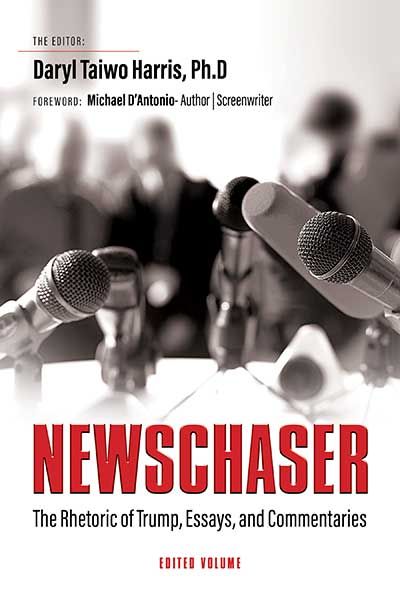Contributing Author/s

Marquita Gammage, PhD
Will Donald Trump Use the Same Scare Tactics and Political Terrorism for Victory in the 2024 Presidential Election? The Truth Is, He Doesn’t Have To.
Will Donald Trump Use the Same Scare Tactics and Political Terrorism for Victory in the 2024 Presidential Election? The Truth Is, He Doesn’t Have To.
On January 20, 2017, Donald Trump’s inauguration as the 45th president of the United States of America was a victory largely predicated on the promise to return America to a nation-state committed to global white supremacy and the marginalization of women, African Americans, and non-white immigrants; also known as the “Make America Great Again” campaign. Was this a result of his political terrorism against women, his anti-Blackness, or his anti-immigrant positioning that secured him the oval office? One must question if this campaign tactic was a singular phenomenon or an interwoven component of the American political system and society. Anti-women and anti-Black political campaigns have been very successful in the past, including for the former president. Thus, we must consider if these ideologies can be sustained in a future presidential election.
Some may argue that these political maneuvers are a thing of the past, evidenced by President Joe Biden’s election victory and the defeat of former President Trump in his bid for reelection. However, historical analyses point us to short-term trends that shift the political landscape of America. Somehow racism and sexism always seem to boomerang their way back to the centerfold of American politics, laws, and culture.
Take, for instance, the backlash to the gains of the 1950s and 60s Civil Rights Movement that resulted in the passage of the Civil Rights Act of 1964, the Voting Rights Act of 1965, and the Fair Housing Act of 1968. Months later, in November 1968, Richard Nixon was elected the 37th president of the United States after advancing a ‘law and order’ campaign that sent shock waves through Black and Hispanic communities. He advanced policing policies and practices that unfairly and almost exclusively impacted Black and brown peoples. In Nixon’s acceptance speech, he argued it was time for new leadership to address the unprecedented lawlessness. Nixon later introduced the phrase ‘War on Drugs’, which is argued to be a racially motivated campaign (Alexander 2012, Jones 2020) adopted by future presidents, including Regan. The sheer numbers of Blacks and Hispanics swept up in the War on Drugs is used to validate these analyses, along with the clear biases in-laws and sentencing practices, such as the 100 to 1 crack versus powder cocaine sentencing disparity, that greatly contributed to the prison boom and the rise of convictions for drug offenses for people of color (Alexander 2010). The Regan, Bush, and Clinton presidencies also launched campaigns against drug crimes that accelerated the ‘War on Drugs.’
According to Michelle Alexander,
| “The racial bias inherent in the drug war is a major reason that 1 in every 14 Black men was behind bars in 2006, compared to 1 in 106 white men” (2010, 98).“ |
Again, in 1981, Regan expanded the idea that America needed to return to its core values and culture of the 1950s with his “Let’s Make America Great Again” campaign. Both Nixon and Regan, along with others, called on the American public to restore America to a state of white male-dominated politics which included subjugating African Americans and women. Noting the success of white-centric restorative change campaigns, Donald Trump followed suit in 2016 with misogyny and anti-Blackness on the campaign trail. This came on the heels of former President Barrack Obama’s two terms as president and his hope for a more inclusive America. The utility of political terrorism against women and minoritized groups was applied again and worked like a charm.
Trump’s campaign to ‘Make America Great Again,’ by reinstating power to white privilege and white male supremacy, promoted racially discriminatory policies against Muslim refugees, Mexican immigrants, African Americans and interrogated the humanity of women. Trump invoked fear in the White American public; fear of women and minoritized groups. Once in the White House, his racialized and sexist positioning continued and spilled over into his 2020 campaign for reelection.
Despite his victory in 2016, Trump was unsuccessful in his campaign for the presidency in 2020. Were racism and misogyny no longer a necessary ingredient to becoming president, or did Trump’s strategies diverge from the core of white male chauvinism and supremacy? Was the focus of Trump’s response to the global coronavirus pandemic the cause? Did the global endorsement of the Black Lives Matter movement after the heinous murder of George Floyd, Breonna Taylor, and so many others cause a shift in the political climate? Analyzing the statements delivered by Trump while campaigning, we find a continued commitment to maintaining the white American ideals of citizenship and leadership. In his acceptance speech at the Republican National Convention in August of 2020, he lobbied the unrelenting need to preserve the White American way:
“We will rekindle new faith in our values, new pride in our history, and a new spirit of unity that can ONLY be realized through love for our country.” (Trump, August 27, 2020)
“This election will decide whether we SAVE the American Dream, or whether we allow a socialist agenda to DEMOLISH our cherished destiny.” (Trump, August 27, 2020)
“Your vote will decide whether we protect law-abiding Americans or whether we give free rein to violent anarchists, agitators, and criminals who threaten our citizens. And this election will decide whether we will defend the American Way of Life, or whether we allow a radical movement to completely dismantle and destroy it.” (Trump, August 27, 2020)
These statements were used to sway the American public into believing that the core values of white supremacy were at stake, and citizens could not be blind to false claims of righteousness that jeopardized the sovereignty of America. Trump’s condemnation of rival candidate Biden as a threat to the American core values cements Trump’s claims of a nation on the brink of being destroyed. Biden’s campaign spoke to the need to dismantle racial biases in the criminal justice system and disassemble the male chauvinism that retained male privilege in the highest office. Trump responded to Biden, stating “Joe Biden is not the savior of America’s soul – he is the destroyer of America’s jobs, and if given a chance, he will be the destroyer of American Greatness.” (Trump, August 27, 2020)
Similarly, Biden’s selection of an African American and Indian American woman to serve as the vice-presidential nominee was met with ridicule by Trump. His anti-Black women rhetoric intensified throughout his campaign. From taunting Kamala Harris with intentional mispronunciations of her name and mocking her laugh to proclaiming that America must prohibit her from becoming the first woman president. Trump even went to the extent of calling Kamala Harris a ‘monster’ after debating Vice President Pence and called former aide Omarosa Manigault Newman, a Black woman, a dog. His engagement with women of color in general amplified his racialized misogyny.
His confrontational engagements with ‘The Squad,’ four democratic congresswomen of color, demonstrate his systematic subjugation of BIPOC women in leadership. Trump’s strategy in the 2020 campaign focused more on targeted attacks against select individuals, particularly Black women and women of color, while his 2016 campaign ushered in droves of stereotyped assaults against women in general. Nonetheless, sexism and misogyny proved to be an acceptable part of American politics. Although critics, including Joe Biden, challenged Trump’s stance against women of color, large populations of Americans accepted his stance and supported his racist gendered attacks.
Additionally, Trump’s position on immigration targeted specific types of immigrants, those assumed to cross the southern borders of America, as criminal and unentitled to entry. His campaign marketed peoples from nations south of the United States and Muslim countries as dangerous, lawless, and in need of strict penalties. While Trump’s proposed stance on immigration as ‘pro-American’ did appear in his speeches, his anti-immigrant policies may have had a more significant impact with permanent visas declining, refugee admissions dropping dramatically–especially for individuals from Muslim countries–and significant growth in numbers of detentions at the U.S.-Mexican border. However, deportations did not see significant shifts. (Lowther 2020, U.S. Department of Homeland Security) Also, with the rise of challenges surrounding Trump’s response to the deadly coronavirus, the volume of promotions around these racially biased ideologies on immigration seems to have been resurrected from his previous campaign.
Examining Trump’s campaign speeches reveals a continued trajectory from his previous strategies that framed women of color as unfit for leadership and Blacks and Hispanics as illegal and illegitimate immigrants. While Trump’s misogynistic and racist statements shifted slightly, these tactics remained central to Trump’s campaign for reelection. However, these tactics did not yield the same reward, which is not surprising given the nation’s historic pushback against these types of racialized politics. After all, the nation’s push back against segregation and Jim Crow led to the Civil Rights movement, the rejection against racialized tough-on-crime policies that led to the Black Power movement, and the call for social justice that led to the Black Lives Matter movement. The momentum of these movements rallied the nation around a common call for justice and equity, which disrupted Trump’s political terrorism.
Despite his loss, Trump was able to rally millions of Americans in support of his campaign to “Keep America Great.” On January 6, 2021, Trump supporters took up his charge for citizens to protect the nation’s sovereignty by preventing the confirmation of the newly elected president. The storm of individuals and groups invading the Capital demonstrated the power of political scare tactics that incited fear in thousands and commended Trump’s supports for fighting for Trump’s model of a great nation. Thus, we are sure to see these political maneuvers employed again, especially if Biden holds faithful to his promises to progress social justice, equity, and inclusion.
Will Donald Trump employ the same scare tactics and political terrorism again to ensure a victory in the 2024 presidential election? The truth is, he does not have to. A new wave of white supremacy American politicians have entered the political arena and are prepared to advance Trump’s philosophy on making America their great nation. The campaign strategies used decades ago will be useful as they are most dominant after significant gains on the most marginalized groups, especially African Americans. These campaigns are indeed backlashes against movements that seek to advance the nation to be more just and inclusive to all. Suppose Vice President Kamala Harris enters the 2024 presidential race. In that case, we may again see Trump as a candidate because his scare tactics were more successful against a woman candidate and less successful against a white male. We are sure to witness political terrorism against women and people of color as history demonstrates that racism and sexism are inherently tied to the fabric of America (Asante 2009). How the nation responds is yet to be determined.
References
Alexander, Michelle. The New Jim Crow: Mass Incarceration in the Age of Colorblindness. New York: The New Press, 2012. Print.
Asante, Molefi K. Erasing Racism: The Survival of the American Nation. New York: Prometheus Books, 2009. Print.
Jones, Chanelle N. “#LivingWhileBlack: Racially Motivated 911 Calls as a Form of Private Racial Profiling.” Temp. L. Rev. Online 92 (2020): 55.
Trump, Donald. (2020, August 27). “Full text: President Trump’s 2020 RNC acceptance speech.” NBC News. Retrieved November 17, 2020, from [NBC News](https://www.nbcnews.com/politics/2020-election/read-full-text-president-donald-trump-s-acceptance-speech-rnc-n1238636)
Lowther, Ed. (2020, October 22). “US election 2020: Trump’s impact on immigration – in seven charts.” BBC News. U.S. Department of Homeland Security. Retrieved November 17, 2020 from [BBC](https://www.bbc.com/news/election-us-2020-54638643)
Disclaimer:
Article Tags
Related Title/s
Contributing Author/s

